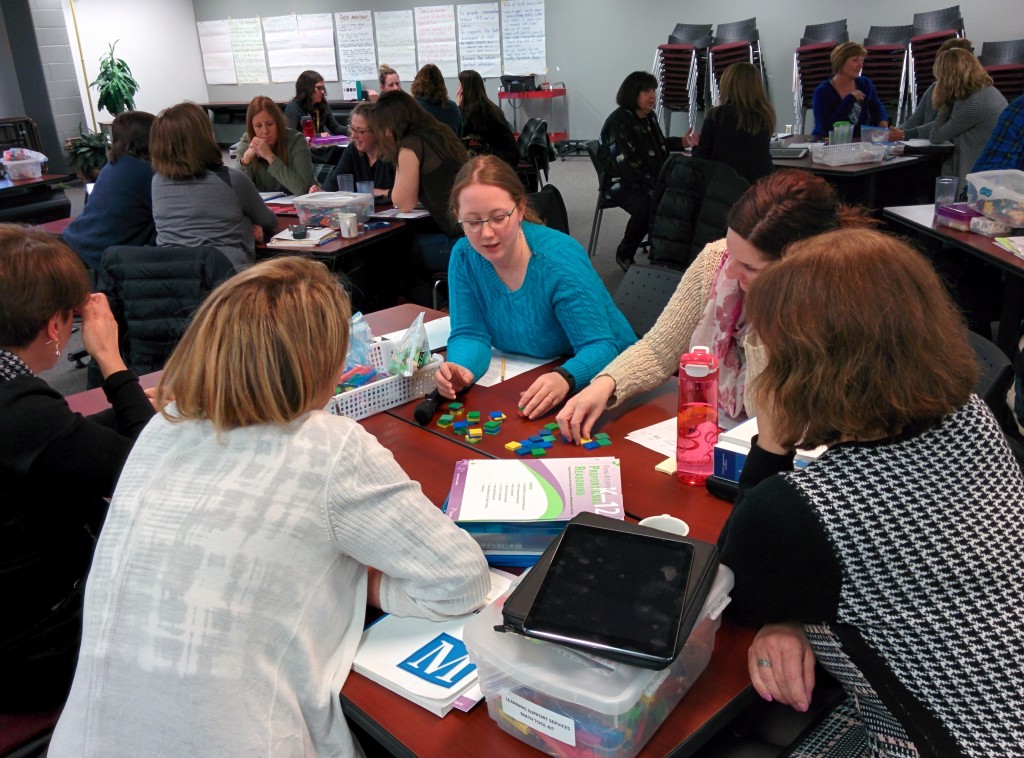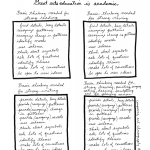While reflecting on this school year, I have come to two realizations about professional development:
- Teachers are looking for professional development that is relevant to their daily roles or a similar program to what you can find here.
- We do not have enough professional development time built into our schedules
With these points in mind, it is important to rethink the professional development model that is used in many schools and districts.
In the past few years, there has been a major shift in instruction for students. We have figured out how to effectively reach students through engaging activities, allowing for student voice and choice. We have also seen a number of educators who are pushing this same shift in professional development. Many of the same characteristics of effective learning are true for teachers as well as students. I believe that it is absolutely necessary to engage teachers in professional learning that is relevant to their daily teaching while being able to provide numerous on-demand opportunities for professional learning. This change in mindset with regard to professional development has allowed me to think past traditional “sit and get” sessions and to incorporate interactive and relevant sessions that allow for teacher voice and choice.
This year, I have used and seen several models for professional development that have truly engaged teachers and met the various needs of educators faced with certain time constraints. Below are some ways that you can use to reinvent professional learning in your district:
Edcamp as District PD Earlier this year our district conducted our first Edcamp (https://fouroclockfaculty.com/2015/02/planning-a-district-edcamp/). The response among teachers and staff members was overwhelming (https://fouroclockfaculty.com/2015/02/reflections-from-edcamp/). While structured a little differently than most Edcamps, our district version gave educators choice in what they wanted to learn about, while providing strategies that were classroom ready the next day. Some teachers learned about the calming effects of yoga on students in the classroom, while many took advantage of sessions offered on various technology resources. A variety of sessions were offered, and led by district teachers sharing their expertise with their colleagues. Ultimately, teachers were able to learn from each other while providing choice served as a great motivator for educators!
Tech-Mex Tuesday or Tech Tuesday These sessions can be offered before, during or after school, and entice teachers with a relevant tech topic as well as free food. Tech Mex Tuesday can be as simple as an overview of a website like geoguessr.com and some chips and dip. Teachers are able to learn about a great website or resource in a less formal setting. Sessions can be offered on a weekly or monthly basis, providing an opportunity to share the latest website you’ve found or a new way to utilize an existing technology piece. Borrow an idea from the LEGO Movie and start Tech and Taco Tuesday at your school!
Lunch and Learn This works much like Tech Tuesday, giving teachers a relevant topic or resource during their lunch time. Many teachers are willing to volunteer their lunch period to learn about a new topic or instructional strategy. Have participants bring their lunch or order a pizza for those participating. Keep it informal and be sure to share a great resource or lesson idea that teachers can take back to their classroom immediately, such as ideas for engineering challenges that will have students utilizing STEM principles (https://fouroclockfaculty.com/2015/05/learning-lab-5-easy-stem-challenges/).
5 Minute PD As our district transitioned to Google Apps for Education, training became difficult because all of the participants came to the sessions with different experience levels and different needs. Enter 5 Minute PD as a quick resource for staff to learn about a particular facet of a program or a quick overview to an app or website. Here is the link for a 5 Min PD – Google Resources we posted on certain Google functions, including Gmail and Drive. Staff members are able to access short videos or web tutorials to learn about a particular topic or refresh themselves on a certain skill.
15 Minute PD One of the biggest challenges with PD seems to be time. For teachers, before or after school PD sessions can impact family schedules and appointments. Some administrators have creatively utilized the 15 minutes before or after school that teachers are contractually obligated to be in the building in order to deliver quality professional development sessions. A good resource or strategy does not have to be shared over a prolonged period of time. A shorter timeframe, like 10-15 minutes can be just enough time to demonstrate a teaching strategy and answer questions. This type of PD session also works extremely well for sharing something that teachers can take immediately back into their classroom, like flippity.net, a great website for students to create digital flashcards or teachers to create brief quizzes using Google Sheets.
Twitter Chats As many connected educators are aware, the benefits of Twitter as an on-demand form of PD are immeasurable. Our district recently took advantage of this, completing a book study of Teach Like A Pirate using a Twitter chat. Teachers new to Twitter were introduced to the concept of a Twitter chat, study questions were shared prior to the chat each week, and teachers joined on Monday evenings at 8pm. The greatest benefit of the evening chat was that educators were able to join in from wherever they were- at the soccer field, in front of the TV, or even from the grocery store- which happened on a few occasions. Inspiration can happen anywhere!
In order for professional development to be effective, it must be designed to engage teachers on relevant topics that meet their various needs. Educators must take advantage of every opportunity to continue their professional learning, using non-traditional timeframes to develop their craft and practice. What types of professional development models have you utilized in your district? Share your ideas for different PD models in the comment section below.
By @RACzyz





Pingback: Technology Coordinator | Pearltrees
I’ve seen planning time shift into prof dev through collaboration. As units are designed together, teachers share their strategies, content strengths, and needs with each other. As assessments are designed together (and student work shared and discussed) teachers continue to learn what’s working, what’s not, and why. Teachers crave this time because it supports their (and their students’) growth. School leaders need to rethink time in order to provide this critical support for teacher development and growth.
Thank you for sharing! Another awesome use of time. Something that must be provided to encourage sharing.
Pingback: Changing the PD Model in Your District | 4 O'Cl...
Pingback: Weekly Education Links (weekly) | A Principal's Life
Pingback: Reflections from #EdcampLdr Philadelphia 2015 | 4 O'Clock Faculty
Pingback: Host a Jam Session |